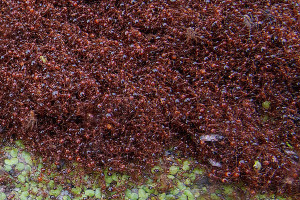
As a typical Rice student traversing campus between classes, work, and various commitments, it is not uncommon for me to walk by many ant mounds throughout a regular day. In fact, on more than one occasion, I’ve unknowingly stepped on one, resulting in a sudden, painful experience as fire ants quickly swarm my legs. Perusing recent news, my attention was drawn to an article, “The Rise of the Crazy Ants,” which I found particularly relevant and interesting. The article describes a new invasive ant species that is gradually outcompeting local fire ants in the southeastern United States. Initially, I rejoiced at the idea of diminished fire ant populations. However, I quickly learned that these “Raspberry crazy ants”, might be an even bigger pest than local fire ants.
UT Austin research assistant Edward LeBrun claims, “They nest in electronics and create short circuits, as they create a contact bridge between two points when they get electrocuted they release an alarm pheromone.” His research has shown that other ants are attracted to this pheromone and gather to create increasingly large nests. This characteristic of “crazy ants” essentially guarantees that we will suffer from their emergence as they invade our homes and destroy our electronics. They have shifted from a more traditional underground, soil habitat to common household items such as boxes, potted plants. This suggests the crazy ants are much more adaptable to environmental changes and could explain why they are outcompeting local fire ants. In fact, these ants actually benefit from habitat disturbances as they are distributed along greater ranges as humans move around their colonies.
By now, there have been multiple reports of their emergence in various areas of the Southeastern US, including Houston. We’ve observed an obvious spread along the United States, including our home Houston, and their detrimental impact on local biodiversity and daily life. Since these crazy ants don’t consume many of the common ant baits available, it is best to refrain from moving a discovered colony to prevent dispersal and call an exterminator when faced with one.
As a student, I am inspired to better understand the underlying biological and ecological factors that allow for the success of the crazy ants. I hope that by spreading awareness, the general public, researchers and policy makers will be inspired to devote efforts and resources towards prevention and control of the crazy ant invasion before it’s too late.


